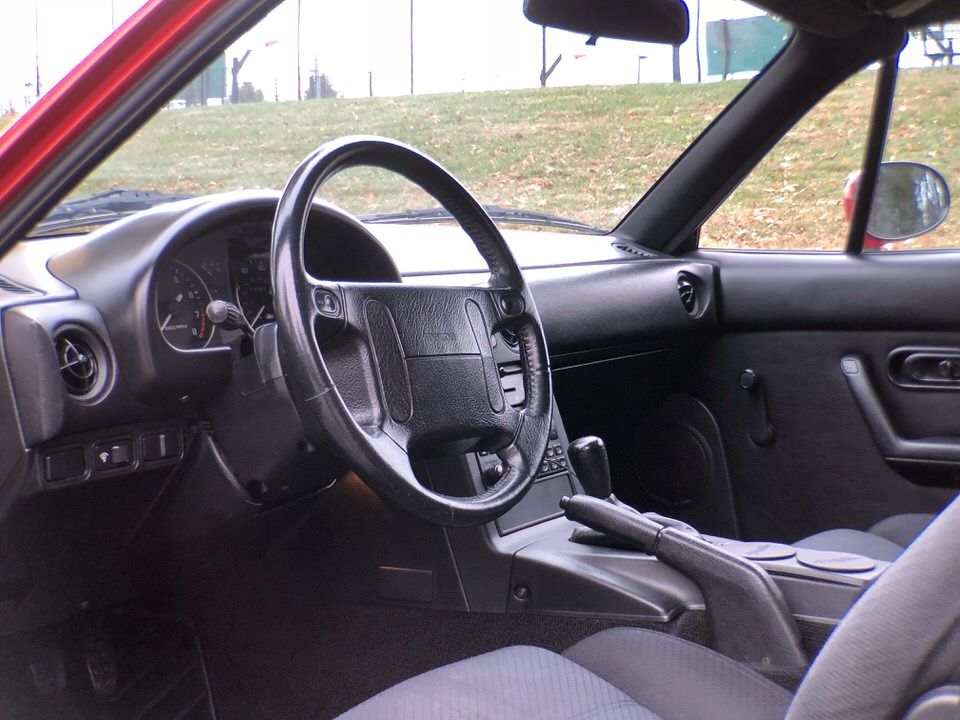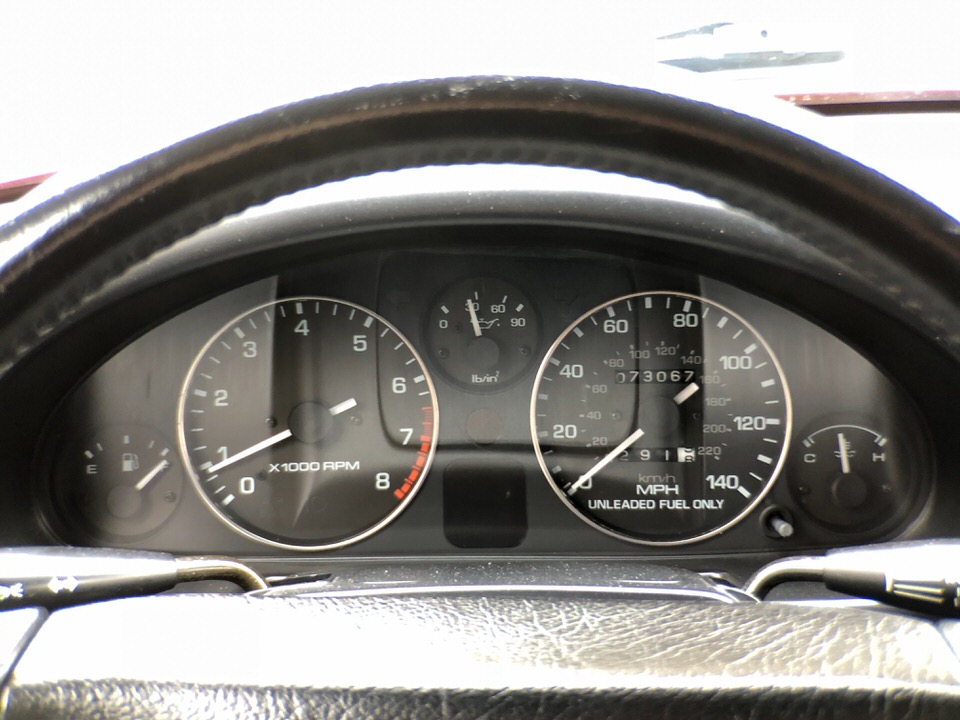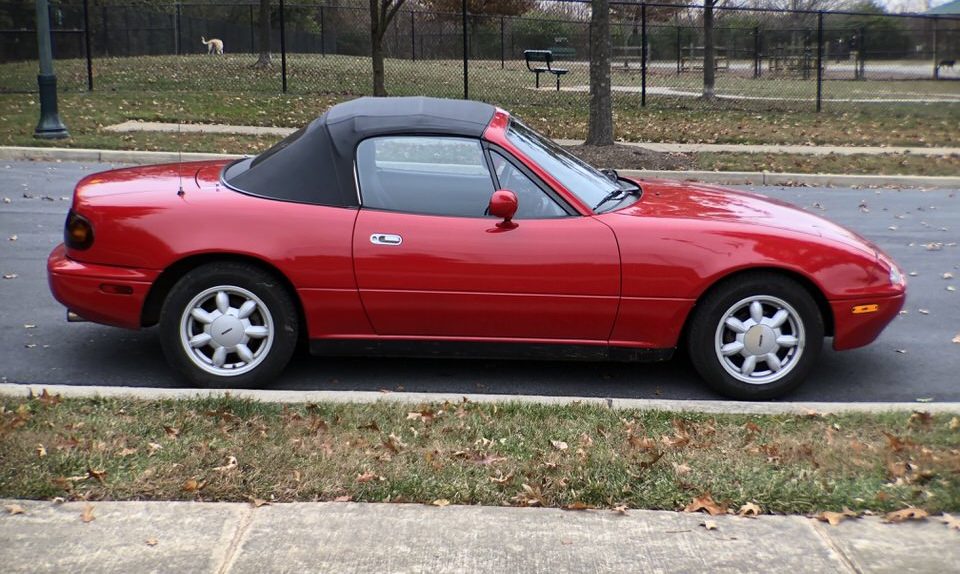Introduction
The 1990 Mazda Miata is the first generation and first model year of a car that essentially reintroduced roadsters to the American marketplace largely abandoned by former British stalwarts like the Lotus Elan, Triumph TR4, MGB, and other cars. Due to a combination of factors – fuel costs, tightening emissions, crash legislation, changing demographics – approachable convertibles left the market. Through the efforts of people like Robert Hall, a car journalist who became a product planner at Mazda, and a team of designers and engineers, the Miata got the green light for production and has been produced each year since without interruption on a global basis.
Motor

The Miata is powered by a double overhead cam 1.6 liter normally aspirated inline four cylinder motor producing 116 hp at 6500 rpm and 100 lb of torque at 5500 rpm. The motor was lifted from Mazda’s 323GTX, a bit of a halo car for in-the-know Mazda enthusiasts, but the car didn’t sell well here in the United States. In the Miata, the top speed is about 116 mph and it squirts to 60 mph in 9.2 seconds. In period, these figures were quite good.
Transmission and Clutch
The Miata comes with a 5 speed manual transmission and a clutch known for its light effort and easy modulation. During my drive I found the clutch picked up about half way through its travel and was very progressive throughout the friction zone. The Miata’s transmission is also well known for it’s short throws, snick-snick precision, and balance. This example was no different. Despite 29 years and 73,000+ miles all five gears were tight and easy to find after a brief introduction.
Chassis and Suspension
The Miata chassis is traditional with a unitary steel body and a fully independent front and rear suspension of double wishbones, coiled springs, and gas filled shocks. Over the years a number of firms have specialized in upgrades and options for further adjustment. The current and third owner of this Miata has preservation in mind and has therefore focused on the car’s traditional feel.
I drove the car on a variety of roads – city streets, the highway, smooth country lanes, some twisties – and the suspension absorbed everything pretty well. This is a road car, so there is real suspension travel on both compression and rebound strokes.
Ergonomics

The ergonomics have stood the test of time well with seats that offer some decent bolstering, yet are soft and offer longer distance comfort. Each of the inputs – steering, gear shift, clutch, brakes – required similar effort. At 5’7”, I found the environment comfortable. The fact this example has been well cared for also played a role in this too.
Wheels, Tires, and Brakes
By today’s standards, the wheel and tires are very small – 14 inch P185/60. But their rotating alloy mass coped with the varied conditions thrown at them just fine – as I expected – and they are attractive to boot. Despite the small size, there are a number of manufacturers making tires in the same size – including snow tires. The brakes were good with a solid feel through the braking stroke and brake force was even at all four corners. No surprise really given the car only weighs about 2200 pounds and is well balanced. There just not a lot of mass to stop during spirited driving.
Instrumentation

The instrumentation is simple but could not be more clear and functional. Essential information – rpm, speed, oil pressure, temp – are front and center. The gauge fonts look as though they taken right from the dial of a vintage Bell & Ross aviator watch. At night the green glow is easy on the eyes and to read at a glance. The chrome bezel surrounds are a nice touch.
On the center console, simplicity is the order of the day and all of it is readily at hand. It has been a long time since I’ve had a chance to manually move heater bars from blue to red – most of my cars have a set-a-temperature and forget – and the throwback was a reminder of how easy and effective these systems are in daily use.
Style and Attention to Detail

While subjective, I think the first generation Miata has always been a good looking car and has aged well. The interior is simple and attractive and in its universal black presents its credentials with a focus around the driver and the essence of driving. The soft top has two straight forward latches and once popped the top just pushes back easily. Ditto when putting the top back into place. No fuss.
Attention to detail is a combination of what you see and touch and what you don’t. What you don’t see, but you do experience, is their attention to weight reduction. A lot of effort went into pairing weight and centralizing mass to improve the driving experience. The team did a great job. The attention to detail for what you do see is a pleasing shape with even panel gaps. It’s a powertrain that with a bit of maintenance will last for a very long time. You also see the detail in how the switchgear operates now – 29 years later. My tester was in excellent condition, but I’ve seen beaters that still have some of these qualities in place.
Price and Value

The Miata has always been a roadster for everyone and while not inexpensive a nicely equipped car has always been priced around the average new cost of a car in the United States. This first generation sold for about $18,000 new in 1990. Nicely equipped new ones in 2018/2019, adjusted for inflation, cost about a few hundred dollars more in 1990 dollars. Incomes haven’t kept up, but the Miata is a surprisingly affordable car.
Some might argue a roadster is an extravagance or something for certain households – singles, empty nesters, or for those able to afford a third car. Obviously, a family of four and their dog won’t fit in one. But the Miata’s versatility is pretty good from a trunk that can hold a set of golf clubs or a weeks worth of groceries, to it’s ability to seat two in comfort – provided they aren’t over 6 feet. The Miata is very good at a number of things and a gentle compromise in others.
Final Thoughts
Twenty years ago an early red Miata showed up on the used car lot of a Chrysler dealership I drove past once a week. The car sat in the same place for three weeks. On one drive-by I impulsively stopped in, chatted with the salesman, and took the car for an extended test ride. I couldn’t really afford the roadster and therefore didn’t purchase it – one owner, 15k, 3rd household car – but the memory of its energy, liveliness at any speed, and the car’s composure in real world riding conditions always stuck with me. But going back to revisit your heroes – even everyday ones – doesn’t always go well.
In this case, however, reconnecting worked out well. The 1990 car isn’t perfect and as an everyday car for me now, it would be a challenge. However, as a vessel for enjoying some great roads in good weather – or in 26 degree F conditions with snow piles lying around – the Miata does a great job putting a smile on your face and gets one’s car loving karma flowing again.
Notes
Finally, I’d like to thank Leonid for making his Miata available for rent on the Turo platform. The link can be found below:
https://turo.com/rentals/cars/md/rockville/mazda-mx-5-miata/268556?searchId=vchr5THw





Scott, really enjoyed reading your post! Sounds like you had a great trip, although you are a braver man than I am for putting that top down with temperature being what it was. I think we really need to share the love for these “modern classic” cars as the whole driving experience is becoming more digital. Thanks for doing your part and hope you have many more automotive adventures!